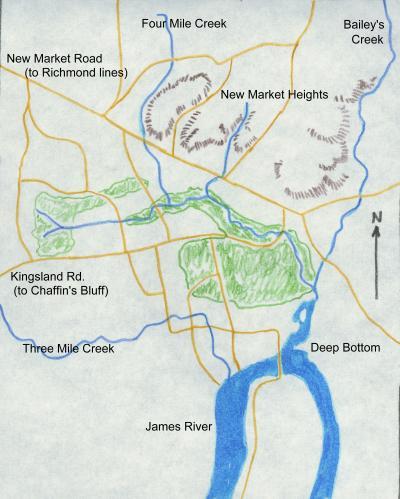 This map is based on the one on
page 32 of Richard Sommers's Richmond
Redeemed, and shows the
general topography of the area just north of Deep
Bottom. This map is based on the one on
page 32 of Richard Sommers's Richmond
Redeemed, and shows the
general topography of the area just north of Deep
Bottom.
Federal
operations in this area were constrained by the
watercourses and the presence of New Market
Heights. If the Yankees crossed west of the mouth
of Bailey's Creek, they avoided having to fight
across that stream, but at the same time had to
directly assault the Rebel lines on New Market
Heights. If they crossed east of Bailey's Creek,
they could avoid the heights by marching inland
and taking the position in flank, but this would
require forcing a crossing of Bailey's Creek, as
well as a longer flank march.
The
Federals launched three expeditions into this
area, using pontoon bridges across the James on
either side of the mouth of Bailey's Creek. In
late July of 1864, Hancock took II Corps into
this area to the east of Bailey's Creek and
tried, unsuccessfully, to turn the Rebel lines
farther north than this map shows. This was part
of the operations connected with Burnside's mine, and led to a series of
engagements known variously as Darbytown Road,
Deep Bottom, Strawberry Plains, and New Market
Road. Less than a month later, in mid-August, II
Corps and X Corps were both sent to operate in
this area, leading to Fussell's Mill, Second Deep
Bottom, Second Darbytown Road, etc.
Finally,
in late September, Birney led X Corps across the
pontoon bridge again, while Ord took XVIII Corps
across the James at a point a few miles further
upstream. While Birney tried to directly assault
the Confederate lines in front of New Market
Heights and along the New Market Road, Ord was
able to directly assault and capture Fort
Harrison on the outer Richmond defenses. Ord's
appearence forced the Confederates to evacuate
the New Market line, which fell to Birney's X
Corps troops. This is usually known as the Third Battle of New Market
Heights.
The
Federal bridgehead at Deep Bottom was vital to
the eventual success of the siege operations, for
it enabled Grant to operate on something
approximating interior lines with respect to the
Confederate defenses. Lee could not ignore the
possibility of a Federal coup
de main being launched
against Richmond, and Butler's success in late
September forced Lee to detach more troops to
watch the Northside sector of his lines, troops
he could ill afford to spare.
|